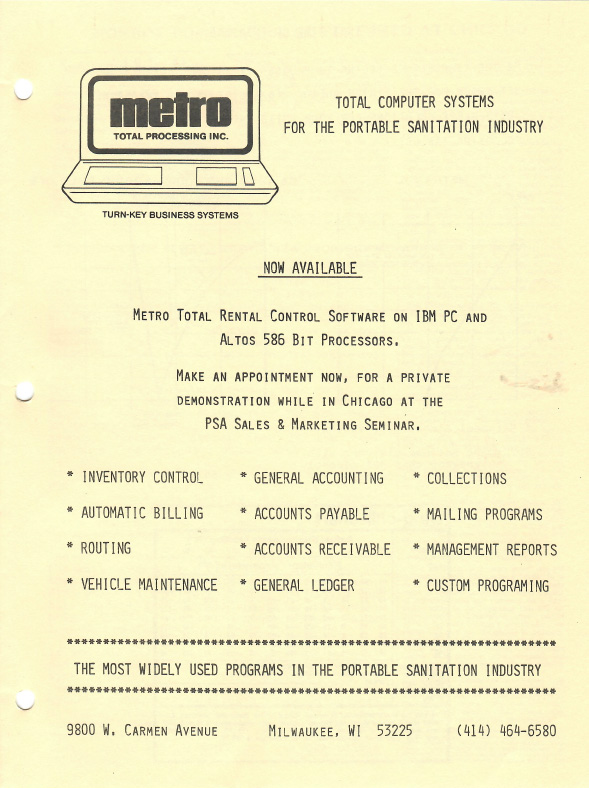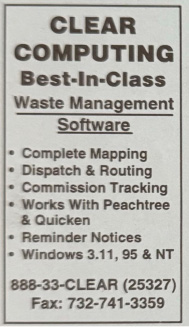Technology in the Portable Sanitation Industry Pre-Y2K
Imagine running your company today based on yesterday’s technology. We take a lot for granted, but imagine a world where personal computers are a rarity, cell phones are in early development and coverage is lacking, printed and hand-drawn maps are the standard (as GPS is unknown except to the military and the space program), and the word “smart phone” is unknown and these devices were decades away from implementation.
Our industry has always been innovative and constantly seeking to improve customer service, employee satisfaction, and environmental quality. The adoption of new technology has been evident in portable sanitation since its founding.
1970s
As the PSAI was just beginning in the 1970s, Bill Gates and Paul Allen established Microsoft in 1975. The following year, Steve Wozniak designed the Apple I computer and later he and Steve Jobs co-founded Apple Computers.
1980s
In the 1980s, just as polyethylene portable restroom units were becoming the standard in our industry, personal computers were just beginning to be developed and marketed. In 1981, IBM released its first personal computer and in 1984, Apple released the Macintosh Computer. Microsoft released Windows 1.0 in 1985 and the “computer revolution” began.
 A late 1980s era Macintosh computer and CRT screen. Photo by Tomas Martinez on Unsplash
A late 1980s era Macintosh computer and CRT screen. Photo by Tomas Martinez on Unsplash
Another monumental technological advance occurred in 1983, as the first cell phone was approved by the Federal Communications Commission. The Motorola DynaTAC 800X was introduced and quickly became nicknamed “The Brick,” according to the Textline.com blog. Their post says that “the device weighed 2 pounds, had a 30-minute battery life, and was priced at $3,995.00” ($12,650 in 2024 dollars).
The portable sanitation industry was active in these exciting times of technological progress. In January 1984, the PSA in Action Newsletter featured the first Supplier Member from the computer industry—Metro Total Processing, Inc. Their ad proudly proclaimed, “Total Computer Systems for the Portable Sanitation Industry.”

The areas where operators could save time and money must have been overwhelming in that day: billing, collections, accounting, routing, reports, and customer mailing programs. Even better customer service and more opportunities to further expand in this growing industry.
In November 1988, the PSA Annual Meeting and Trade Show Buyers Guide for the Fort Worth, Texas, event shows that GMF Associates of Johnstown, Pennsylvania, was now a Supplier Member. GMF was founded by Tom Edwards, who also owned a portable restroom company in that same area, J-Town Johns. Their ad highlights even more time-saving features while emphasizing the printing capabilities of their program. “On-site Setup and Training” would have been a huge benefit at that point.

1990s
By the 1990s, notebook computers were introduced, email was promoted by America Online, the concept of the “world wide web” began, websites were developed, software programs were more advanced, Wi-Fi was introduced, and several new companies were launched—namely, Amazon, eBay, and Google.
From the May 1993 PSA in Action, while we do not have a lot of information to draw upon, the list of Supplier Members shows:
“JRM Software” located in Modesto, California, with Jeff Hayes being the primary contact. (If anyone is familiar with this company, please share this information and we will gladly update our records.)
In 1994, Textline.com reports that the first smartphone was released by IBM. “The Simon Personal Communicator” had a touchscreen and users could make phone calls, receive emails, and faxes. IBM Simon had a price of $1,099 ($2,350 in 2024 terms) and sold 50,000 units in the first 6 months.
In Fall 1995, Clear Computing, Inc. was founded by Meryl and Joel Smith in Monmouth County, New Jersey. They soon joined the PSAI, and the company became an active longtime member of the association. Here is an ad from circa 1996 demonstrating even more advancements in technology for our industry.

Y2K
For those of you too young to remember, Y2K refers to the Year 2000. Many experts predicted a total collapse of computer systems because of the inability of computers to distinguish between 1900 and 2000 as the 2-digit year would be the same, “00.” Further, most computer systems and software had always used the date “12/31/99” to indicate ongoing, non-expiring time periods. (After all, in 1980, didn’t 12/31/99 seem like “forever” in the future?) Fortunately for the world, Y2K was mostly a non-event and technology continued to grow and to expand. (FYI, just as a precaution, this is now why we use the 4-digit year on forms and documents.)
Epilogue: From 2000 to Current
Here are a few interesting milestones in technology in this century, courtesy of Corbin Ball & Co.’s publication, 1962-2022: A 60-Year Timeline of Events Technology Innovation:
- 2000: GPS became available to civilian users. Surveys show that 60% of U.S. households owned at least one computer.
- 2001: Apple released the iPod, which became the most popular MP3 player in history and changed the music industry. Wikipedia was launched.
- 2003: The amount of spam email exceeded the amount of legitimate email for the first time.
- 2004: Facebook (limited to Harvard University students only) began.
- 2005: YouTube was founded.
- 2007: Apple introduced the iPhone.
- 2010: Apple introduced the iPad. According to Corbin Ball & Co., “there are now 4.7 billion mobile phone subscriptions (2 out of every 3 people on the planet.)”
- 2011: Corbin Ball reports, “there are now more than 800 million Facebook users (more than 1 in 10 on the planet).”
- 2015: Microsoft released Windows 10 (remember, Windows 1 came in 1985).
From the PSAI Archives
- 2017: In January, Clear Computing merged with 1bg.com to form ServiceCore.
- 2019: Longtime PSAI Supplier Member RouteOptix (founded in 2000 by Ron and Marion Davey from Kitchener, Ontario, Canada) was acquired by Routeware.
- 2020-2022: COVID dramatically altered the workplace with Zoom (and similar programs) nearly eliminating conference calls and working from home became viable and acceptable.
Final Thoughts
As technology has changed, so has our industry. We continue to remain at the forefront of innovation as we serve the world’s fundamental needs.
For even more interesting facts on the history of our Industry and of our Association, click on the link below and order your History Book today. All proceeds benefit the PSAI Scholarship Program.
